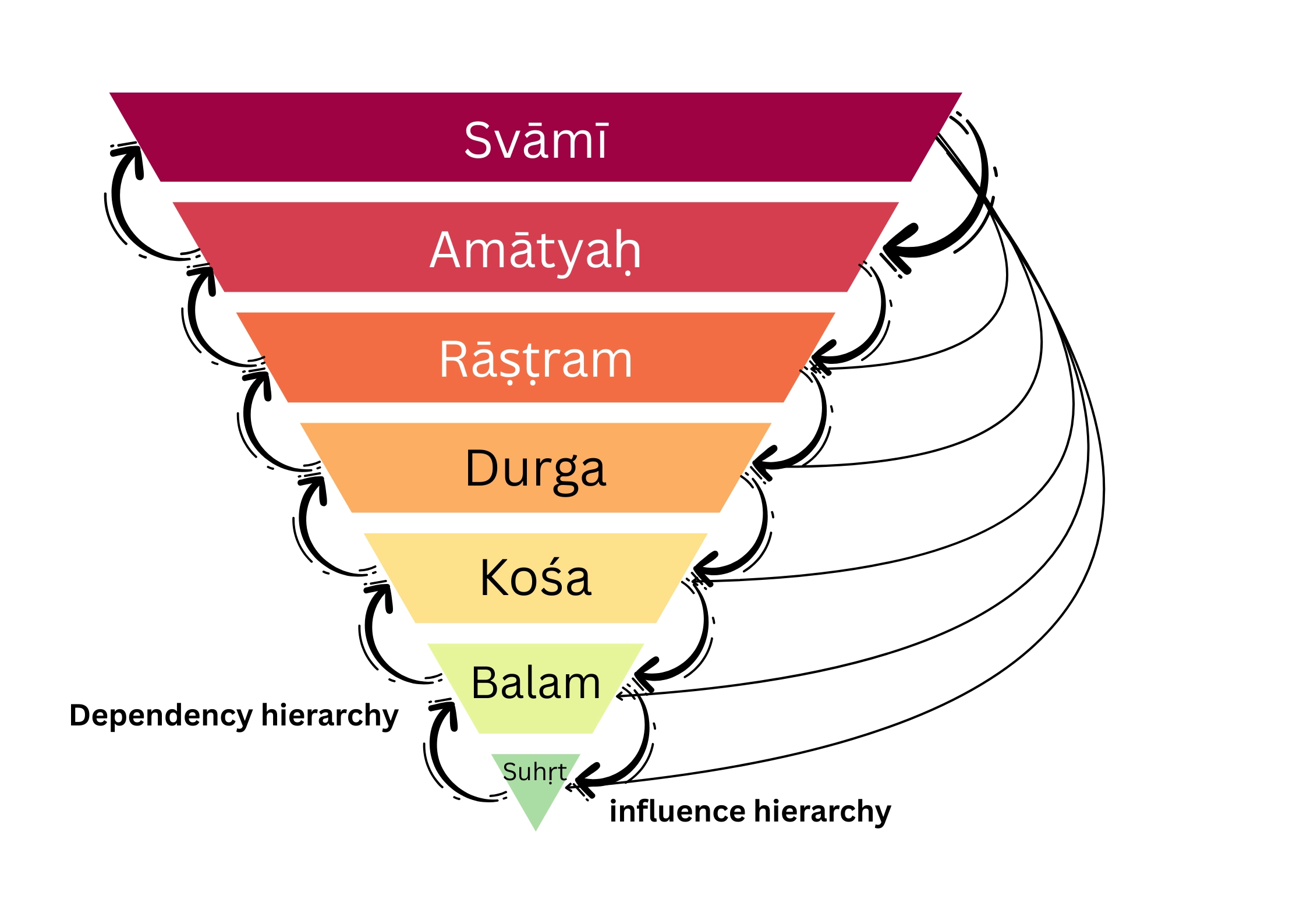For any society to thrive, it is imperative to establish a stable model of state and governance grounded in principles that are timeless and enduring. In an age characterised by rapid changes across diverse domains such as technology, commerce, and geopolitics, there arises a pressing need to re-examine and reassert the eternal principles of governance and statecraft. Bhārata is uniquely privileged to possess a vast and profound intellectual tradition encompassing a wide array of subjects, offering valuable insights for the flourishing of humanity. Among its many contributions are seminal texts such as the Arthaśāstra, the Kāmandaka Nītisara, and several other treatises that provide comprehensive perspectives on the nature and functioning of state and governance. However, due to the lasting impact of colonization and various other factors, the opportunity to reconstruct a post-independence Bhārata rooted firmly in the foundational Bhāratīya principles of governance was not fully realized. In this article, we endeavour to revisit the concept of statecraft and governance through a śāstrika lens.
Nīti
Before engaging with the śāstrika perspective on state and governance, it is necessary to understand the definition of nīti, as the nature of state and governance is primarily addressed within the domain of nītiśāstra.
A definition of nīti is found in the Upādhyāyanirapekṣā, a commentary on the Kāmandaka Nītisāra:
pratyakṣa-parokṣānumāna-lakṣaṇa-pramāṇ-atraya-nirnītāyāṃ phalasiddhau deśakālānukūlye sati yathāsādhyaṃ upāyasādhanaviniyogalakṣaṇā kriyā. Upādhyāyanirapekṣā - 1-6
This definition conveys that nīti refers to the act of taking or implementing measures aimed at achieving a particular outcome, an outcome which is to be established through the threefold means of knowledge or pramāṇas — namely pratyakṣa (direct perception), parokṣa (indirect or scriptural knowledge), and anumāna (inference). Moreover, the application of any action or strategy must be guided by a careful consideration of the prevailing conditions of deśa (place) and kāla (time), thereby ensuring relevance and efficacy.
The distinction between nīti and dharma lies in their epistemological grounding. Dharma is primarily based on śabda pramāṇa, or authoritative scriptural testimony. In contrast, nīti involves the practical implementation of dharma, where its applicability and appropriateness are assessed and validated through pratyakṣa (empirical observation) and tarka (logical reasoning). Thus, while nīti is ultimately rooted in śabda pramāṇa, it is supported and scaffolded by pratyakṣa and anumāna, ensuring that its implementation is both contextually relevant and pragmatically sound.
State
The term in Saṃskṛta that most closely corresponds to the modern concept of the state is rājyam.
svāmyamātyaśca rāṣṭrañca durgaṃ kośo balaṃ suhṛt
etāvaducyate rājyaṃ sattvabuddhivyapāśrayam
Kāmandaka Nītisāra* 1.18
A rājyam is described as a composite of seven essential elements. These are:
1. Svāmī – The sovereign or ultimate authority who presides over the other six components of the rājyam. The character and nature of the state are intrinsically shaped by the disposition, vision, and conduct of the svāmī.
2. Amātyaḥ – Etymologically, amātya derives from amā (with the king) and atanti (to work across various domains of the rājyam). Thus, amātyas are those who work alongside the king, assisting in governance and implementation of policies essential for the state's prosperity. This category includes ministers, advisors, and various administrative officials.
3. Rāṣṭram – One of the commentaries on nītiśāstra equates rāṣṭram with janapada, derived from janasya padam—the land or space inhabited by people. Hence, rāṣṭram may be understood as the inhabited regions of the state, encompassing towns, cities, and other settlements.
4. Durga – The term durga refers to either natural or man-made fortifications that are difficult to penetrate or conquer. Accordingly, durga may be interpreted as encompassing forts, border outposts, and other critical security installations that provide protection and strategic advantage to the state.
5. Kośa – The word kośa is etymologically connected to kuśyate ākṛṣyate āyassthānebhyaḥ, meaning the place that attracts sources of wealth. Thus, kośa signifies the economic foundation of the state, including its treasury and systems for revenue generation.
6. Balam – Literally meaning “strength”, balam in this context refers to the state's defensive and offensive capabilities. This includes all categories of military and paramilitary forces that ensure internal security and external defense.
7. Suhṛt – While suhṛt literally means “friend”, in the political and strategic context of rājyam, it refers to allies — those external entities whose support and cooperation enhance the state's security, influence, and stability.
Pt. Rajeshwar Shastri Dravidji believes that the order in which the seven elements of a rājyam (state) are listed is meaningful. Starting from suhṛt (allies) and moving up to svāmī (ruler), each element becomes more important than the previous one and also influences the next. For instance, balam (military strength) is more important for the functioning of a rājyam than suhṛt, because balam determines who your allies will be. If a rājyam has strong and capable defense forces, other countries will naturally want to ally with it.
In the same way, kośa (treasury or economy) is more important than balam, because the strength and capability of the defense forces depend on the resources available in the kośa. Without a strong economy, a state cannot maintain a strong military.
Similarly, svāmī (the ruler) is the most important element of all. The qualities and leadership of the svāmī directly affect the performance not only of the amātyaḥ (ministers and administrators) but also of all the other elements of a rājyam. The success of the state depends largely on the character, wisdom, and actions of the svāmī.

The second half of the aforementioned śloka, sattvabuddhivyapāśrayam, states the foundational principles upon which a rājyam (state) must be established. The verse highlights sattva and buddhi as the two essential pillars of statehood.
(i) Sattvam – The commentary on sattvam is vyasane abhyudaye ca yadavikāri, which refers to a state that remains unaffected by either favourable or unfavourable circumstances. This implies that the resilience and stability of the state should not waver in the face of prosperity or adversity. Such equanimity reflects strength of character and institutional maturity.
(ii) Buddhi – The commentary on the term buddhi is ‘śuśrūṣādyaṣṭaguṇāḥ prajñā’, which denotes wisdom gained through eight distinct methods or qualities. These eight are as follows:
-
Śuśrūṣā – The eagerness and readiness to listen to and obey one’s teacher or elders.
-
Śravaṇam – The act of acquiring knowledge under the guidance and tutelage of a knowledgeable authority or elder.
-
Grahaṇam – The ability to grasp or internalise the knowledge received.
-
Dhāraṇam – The capacity to retain or hold the knowledge that has been internalised.
-
Ūha and -
-
Apohaḥ – These two refer to the processes of logical reasoning and analytical thinking, involving both inference and negation.
-
Arthavijñānam – The discernment and understanding of the meaning or significance of what has been learned.
-
Tatvajñānam – The realisation or comprehension of the ultimate truth.
Together, sattva and buddhi serve as the foundational qualities that must underpin the structure and functioning of a well-ordered rājyam. While sattva ensures composure and integrity, buddhi ensures the presence of informed, reflective, and wise governance.
Stability of the Rājyam
The stability of a rājyam, when rooted in sattva, is made possible through the cultivation of three essential qualities:
tyāgaḥ satyañca śauryañca traya ete mahāguṇāḥ.
prāpnoti hi guṇān sarvān etairyukto mahīpatiḥ.
Kāmāndaka Nītisāra, 4.23
This verse from the Kāmandaka Nītisāra identifies tyāga (generosity), satya (truth), and śaurya (valour) as three noble qualities that must be consciously cultivated by the king. These virtues are not simply idealistic in nature; they form the very basis for meeting the fundamental needs of the people. A stable and well-governed rājyam must address three primary expectations of its citizens:
- Livelihood
- Justice
- Protection
It is through the practice of these three qualities that the king, along with the other components of the rājyam, is able to ensure these necessities.
In the present context, tyāga goes beyond the idea of personal sacrifice; it refers to the responsibility of distributing the wealth of the nation through appropriate policy measures, public initiatives, and the creation of opportunities for all sections of society.
Satya implies a firm adherence to truth, which serves as the foundation for delivering justice impartially and consistently.
Śaurya, or valour, is essential not only for the king and the armed forces, but for all organs of the state tasked with ensuring security and order.
Thus, the stability of a rājyam depends not only on the foundational attributes of sattva and buddhi, but also on the presence and active practice of tyāga, satya, and śaurya across all levels of governance.
Governance
The concept of governance finds its origins in the Vaidika corpus. In the Taittirīya Brāhmaṇa (2.2.10), we encounter the expression ‘tato vā indro devānām adhipatir abhavat’, which translates to “thereafter, Indra became the sovereign of the gods.” This passage indicates the early Vaidika recognition of structured leadership and rulership, exemplified through the elevation to divine status of kingship in the figure of Indra, who is portrayed as the supreme authority among the devas. Furthermore, in the Sāyaṇa Bhāṣya on the Rudrādhyāya, for the mantra, 'matiśca me sumatiśca me' (Taittirīya Saṃhitā – 4.7.2), the term sumati is interpreted as, 'durghaṭa-rājakāryādi-niścaya' (Sāyaṇa Bhāṣya, Taittirīya Saṃhitā – 4.7.2), which denotes the discernment or resolution of intricate and challenging matters, particularly those related to statecraft.
Additionally, in the Chāndogya Upaniṣad (7th chapter), when Sanatkumāra questions Nārada regarding the extent of his studies, Nārada responds with the following enumeration:
Ṛgvedaṃ bhagavo'dhyemi yajurvedam sāmavedam ātharvaṇaṃ caturtham, itihāsapurāṇaṃ pañcamaṃ vedānāṃ vedaṃ, pitryaṃ rāśiṃ daivaṃ nidhiṃ vākovākyaṃ ekāyanaṃ devavidyāṃ brahmavidyāṃ bhūtavidyāṃ kṣatravidyāṃ nakṣatravidyāṃ sarpadevajanavidyāṃ etad bhagavo'dhyemi.
Chāndogya Upaniṣad* – 7.1.2
This translates as:
I have studied the Ṛgveda, the Yajurveda, the Sāmaveda, and the Atharvaveda as the fourth. I have also studied Itihāsa and Purāṇa as the fifth Veda. Additionally, I have studied vākovākya (disputation or logical discourse), ekāyana, devavidyā (knowledge of the gods), brahmavidyā (metaphysical knowledge), bhūtavidyā (knowledge of elements), kṣatravidyā (political science or statecraft), nakṣatravidyā (astronomy), sarpavidyā (serpent-lore), and devajana-vidyā (knowledge of celestial beings).
In this context, Ādi Śaṅkarācārya interprets the term ekāyana as referring to nītiśāstram (Śāṅkara Bhāṣyam, Chāndogyopaniṣad - 7-1-2) — the science of ethics and governance. This interpretation is further substantiated by Bhagavatpāda, who affirms that such a meaning is not a later innovation, but a traditional understanding rooted in the Vaidika period and perpetuated through generations.
Moreover, references to governance and statecraft are found abundantly in various Purāṇika texts such as the Agni Purāṇa, Bhaviṣya Purāṇa, and Matsya Purāṇa, as well as in the Bhagavad Gītā. Notable examples from the Gītā include the phrases:
- ‘nītiḥ asmi jigīṣatām’ (“Among those who seek victory, I am policy,” – Bhagavad Gītā 10.38)
- ‘ jayaḥ asmi’ (“I am victory,” – Bhagavad Gītā 10.36)
- ‘vyavasāyaḥ asmi’ (“I am decisive determination,” – Bhagavad Gītā 10.36)
All of which indicate the divine association with principles of governance and administration.
Verses such as ‘janānurāgaḥ prabhavā hi sampadaḥ’ (Jayamaṅgalā, commentary on Kāmandaka Nītisāra – 1.24) shed light on the fundamental objective of governance: the cultivation and sustenance of anurāga, the affection and goodwill, of the people. In this context, Rājēśvara Śāstrī Drāviḍa further underscores the importance of the virtues of tyāga (sacrifice), satya (truthfulness), and śaurya (valor), and asserts that governance imbued with these qualities naturally fosters janānurāgaḥ — the heartfelt allegiance of the citizens.
This concept finds a clear articulation in the Arthaśāstra (1.13), wherein Kauṭilya (Cānakya) emphasizes the necessity of governance during periods characterized by mātsyanyāya — a condition wherein, in the absence of law and order, the strong exploit the weak. The text states:
Mātsyanyāyābhibhūtāḥ prajā manuṃ vaivasvataṃ rājānaṃ cakrire. Dhānyaṣaṅgāgaṃ paṇyadaśabhāgaṃ hiraṇyaṃ cāsya bhāgadheyaṃ prakalpayāmāsuḥ.
That is,
The people, oppressed by Mātsyanyāya, appointed Vaivasvata Manu as their king. They assigned him one-sixth of the grain produced, and one-tenth of their merchandise and wealth, as his legitimate share for the performance of his royal responsibilities.
The concept of Mātsyanyāya is further elucidated in the following verse:
asti matsyaḥ timirnāma tathā matsyastimiṅgilaḥ।
timiṅgilagilopyasti tadgilopyasti rāghava॥
Hanumannāṭaka – 8.47

This śloka captures the essence of Mātsyanyāya — the Law of the Fish. It presents a vivid image of a world devoid of order, governance, or judicial oversight, where the stronger inevitably prey upon the weaker. The verse metaphorically describes a succession of increasingly larger and more powerful fish, each devouring the smaller one, thereby symbolizing a natural order based solely on might in the absence of regulatory structures.
Mātsyanyāya, therefore, signifies a state of social and moral disintegration wherein individuals or groups possessing superior strength or resources dominate, exploit, and suppress those who are weaker or defenseless. In such a context, without a centralized authority to uphold justice and safeguard the rights of all members of society, the social fabric collapses into chaos, driven by unrestrained force rather than guided by principles of fairness and equity. The śloka powerfully underscores the imperative for organized governance, which alone can curb such predatory behavior and preserve the dignity and security of every individual.
The passage from the Arthaśāstra thus reflects the fundamental social rationale underpinning the institution of governance — where the ruler is entrusted by the populace with authority and resources, in exchange for the assurance of justice, societal order, and protection from anarchy.
Conclusion
The insights drawn from the Vaidika and Śāstrika corpus provide clear guidance that a state or system of governance aligned with Dhārmika principles results in a sustainable model. Hence, revisiting and rediscovering these eternal principles of statecraft and governance is an imperative endeavor for the present time.







